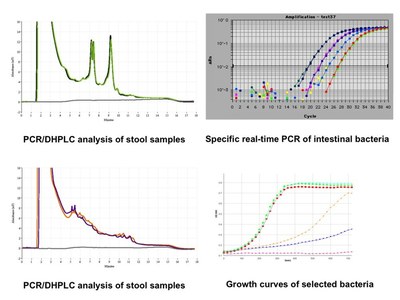Teilprojekt 3 - Stuhlflora und Fermentationseigenschaften
Zusammensetzung der individuellen Stuhlflora und Fermentationseigenschaften ausgewählter Darmmikroben
Work package 3:
Composition of the individual microbiota and fermentation characteristic of selected microorganisms
Project team: Prof. Dr. Eugen Domann, Prof. Dr. T. Chakraborty, Dr. Maren Limberg, FB 11, JLU
Email: Eugen.Domann@mikrobio.med.uni-giessen.de
Background
Recent molecular techniques showed that human beings are colonised with myriads of microorganisms, mainly bacteria. These bacteria colonise habitats such as the skin, the oral cavity, the urogenital tract and the gastrointestinal tract called microbiota. Therefore, the symbiosis of humans and microbes was also termed as “superorganism”. The predominant amount of bacteria is located in the intestine with a concentration of up to 1011 bacteria per gram stool. The intestinal symbiosis results e.g. in interacting metabolic pathways between human being and microbes and the metabolism of nutrients or drugs by the intestinal microbiota (Li et al., 2008). Therefore, the composition of this microbiota may even influence the body weight (Ley et al., 2006). Recent calculations showed that the intestinal microbiota is composed of approximately 500 to 1,500 different bacterial species, predominantly belonging to Proteobacteria (~46%), Firmicutes (~32%), Bacteroidetes (~20%) and Actinobacteria, Verrucomicrobia, Fusobacteria (~2%). The composition of the intestinal microbiota is individual and depends on age, lifestyle and diet (Gill et al., 2006; O’Hara and Shanahan, 2006). In order to determine the members of the intestinal microbiota, modern molecular techniques such as PCR, next generation sequencing and bioinformatic tools are inevitable. The Institute of Medical Microbiology has developed and runs technologies to analyse polymicrobial infections and the composition of different microbiotas such as denaturing-high performance liquid chromatograpy DHPLC, real-time PCR, microarrays, transcription analysis and sequencing (Domann et al., 2003; Imirzalioglu et al., 2008, Hossain et al., 2002, Knösche et al., 2008, Chatterjee et al., 2006).
Aims
Firstly, it is projected to analyse the intestinal microbiota of subjects prior to and after the consumption of juices with a high amount of anthocyanins (intervention study, Giessen) and from subjects belonging to the DONALD study (Dortmund). After nucleic acid extraction the composition of the intestinal microbiota will be determined by using PCR/DHPLC analysis, real-time PCR, DNA sequencing and bioinformatics. Secondly, it is projected to examine the impact of anthocyanin-rich berry extracts on the growth and metabolism of selected intestinal bacteria belonging to important families of Bacteroidetes and Firmicutes. It is intended to run growth curves, microarrays and mass spectroscopy.

